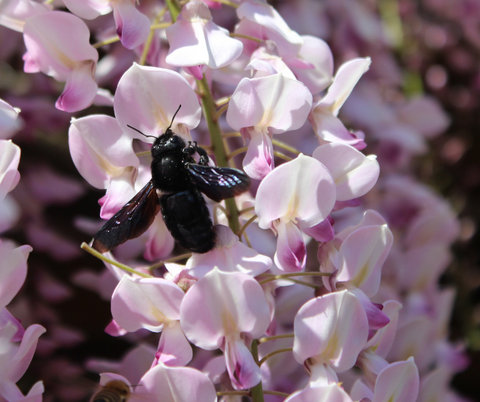Types of Carpenter Bees
Carpenter bees are one of the non-aggressive types of bees known for causing immense and irreparable damage to any wooden structures, especially soft wood materials. As a carpenter builds with wood, these bees make their nests by drilling the wooden surfaces. In hindsight, it’s how they got named carpenter bees.
Here at BeesNThings, not only we do have the resources to help you identify carpenter bees of different types but also we provide solutions to help you get rid of the carpenter bee infestation. To understand more about the different types of carpenter bees that exist across the globe, let’s continue reading,
6 Different Types of Carpenter Bees That You Need to Know
There are hundreds of carpenter bee species that exist around the world but all are from the Xylocopa genus. Based on their color, size, and behavior traits, these bees vary in different types but all of them have similar body structures. A carpenter's bee infestation can be dangerous on your property; therefore, it’s important to understand them.
Carpenter bees can drill holes that are several feet long and weaken the structural integrity of your woodwork or framing components. They can destroy your wooden patio furniture and outdoor wooden structures if neglected and even your wooden lawn ornaments. It’s a good idea to get rid of them as soon as you notice the problem.
Additionally, once they get into your eves and facia boards, they can drill holes in your roof trusses, causing them to sag and slowly buckle under weight and eventually, fail altogether.
Here are the six different types of carpenter bees that exist globally:
 Southern Carpenter Bee (Xylocopa Micans)
Southern Carpenter Bee (Xylocopa Micans)
Xylocopa Micans or also known as the southern carpenter bee is found mostly in southern Virginia. They have a bright metallic exterior with a shiny texture and are avid pollinators. These types of carpenter bees are generally not considered as harmful as they make their nests in natural areas.
 Valley Carpenter Bee (Xylocopa Sonorina)
Valley Carpenter Bee (Xylocopa Sonorina)
One of the Xylocopa subspecies is found on the Hawaiian island. Nevertheless, this type of carpenter bees are a bit different from others as they prefer dry woods mostly not any rotting or decaying wood. This is the reason why Sonorina is considered highly dangerous for homeowners, especially during the springtime.
 Valley Carpenter Bee (Xylocopa Varipuncta)
Valley Carpenter Bee (Xylocopa Varipuncta)
The Xylocopa Varipuncta bees are mostly found in the southwest United States. Often, people confuse this species with Xylocopa virginica as they have similar markings on their abdomen and face. Still, if you inspect them closely, then you can notice that Varipuncta has white hairs more than golden hairs which set them apart.
 California Carpenter Bee (Xylocopa Californica)
California Carpenter Bee (Xylocopa Californica)
This is a subspecies of Xylocopa Virginica, and there are a lot of similarities between them. What sets them apart is that Xylocopa Californica has a more metallic appearance than the Virginica species. They prefer making their nests in dry and soft woods and can be found in Texas, Arizona, and other southwestern parts of the U.S.
 Eastern Carpenter Bee (Xylocopa Virginica)
Eastern Carpenter Bee (Xylocopa Virginica)
Xylocopa Virginica species are the most common type of carpenter bees found in half of the U.S. and even Canada. These species mostly prefer structural timbers for drilling including cedar and pine wood. With this type of bee, the females are the dominant ones while the males exist only for mating.
 Mountain Carpenter Bee (Xylocopa Tabaniformis)
Mountain Carpenter Bee (Xylocopa Tabaniformis)
Xylocopa Tabaniformis are found in Oregon, Utah, and Nevada region and they have ten different subspecies active during different times of the day. Generally, these types of bees prefer building nests in softwoods like cottonwood, incense cedar, coffee plants, coast redwood, and Mexican pine.
Those are the six most common bees found in the world, albeit there are some other variants and subspecies of bees that are closely related to the hornet and wasp. Whether you have a small carpenter bee infestation or a large one with several females drilling holes in your wood, you can find the right bee trap at BeesNThings.
Get Rid of Carpenter Bee Infestations With BeesNThings
Regardless of the type of carpenter bee you see, it can cause danger once they start drilling holes inside your property. Therefore, it’s a must for every homeowner to identify the bee infestation and take the necessary measures to get rid of it. This is why it’s a good idea to get your carpenter bee traps and solutions at BeesNThings
We have some of the best carpenter bee traps made of solid materials that can be purchased at an affordable price. You can place them strategically to catch the bees without harming them. For more information regarding these bee traps and other carpenter bee removal solutions, contact us today and get what you need.

